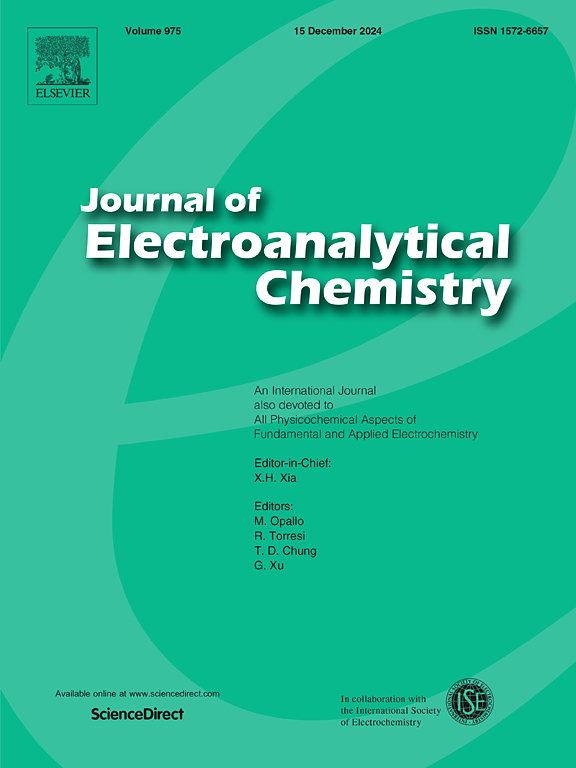Dual-Channel electrochemiluminescence mechanism and bioanalysis of semiconductor solar cell material Cu2ZnSnS4
IF 4.1
3区 化学
Q1 CHEMISTRY, ANALYTICAL
引用次数: 0
Abstract
This study involved the synthesis of Cu2ZnSnS4 (CZTS) via a high-temperature liquid-phase strategy, followed by a comprehensive characterization of its structural and optical properties using a range of analytical techniques. The electrochemiluminescence (ECL) phenomenon of CZTS has been discovered for the first time. Moreover, the use of tripropylamine (TPrA) and persulfate (S2O82−) as co-reactants resulted in CZTS exhibiting highly efficient ECL emission at both positive and negative potentials. The sulfur vacancies in CZTS functioned as electron traps, which enhanced the adsorption and binding affinity of co-reactant radicals. This promoted the interaction between the co-reactant and the ECL emitter, reduced energy loss, and significantly improved the ECL performance of the dual co-reactant system. In light of these findings, a new ECL biosensor was developed, incorporating DNA walker technology, an FTO three-electrode system, and enzyme-free cleavage, facilitating the efficient detection of the biomarker microRNA-141 (miRNA-141). The biosensing mechanism employed a “on-off-enhance on” signal conversion strategy, showcasing remarkable detection performance for miRNAs across a concentration range of 10−16 to 10−10 M, with a detection limit (LOD) reaching as low as 10−16 M. This study broads the potential applications of traditional semiconductor solar cell material CZTS within the field of ECL, offering a theoretical foundation for advancing ECL research and underscoring its applicability in biomedical research and clinical diagnosis.
半导体太阳能电池材料Cu2ZnSnS4的双通道电化学发光机理及生物分析
本研究涉及通过高温液相策略合成Cu2ZnSnS4 (CZTS),随后使用一系列分析技术对其结构和光学性质进行了全面表征。本文首次发现了CZTS的电化学发光(ECL)现象。此外,使用三丙胺(TPrA)和过硫酸盐(S2O82−)作为共反应物,使得CZTS在正负电位下都表现出高效的ECL排放。CZTS中的硫空位作为电子陷阱,增强了共反应自由基的吸附和结合亲和力。这促进了共反应物与ECL发射器之间的相互作用,降低了能量损失,显著提高了双共反应物体系的ECL性能。根据这些发现,一种新的ECL生物传感器被开发出来,结合了DNA walker技术,FTO三电极系统和无酶切割,促进了生物标志物microRNA-141 (miRNA-141)的有效检测。该生物传感机制采用“开-关-增强-开”的信号转换策略,在10−16 ~ 10−10 M浓度范围内对mirna具有出色的检测性能,检测限(LOD)低至10−16 M。该研究拓宽了传统半导体太阳能电池材料CZTS在ECL领域的潜在应用。为推进ECL研究提供理论基础,并强调其在生物医学研究和临床诊断中的适用性。
本文章由计算机程序翻译,如有差异,请以英文原文为准。
求助全文
约1分钟内获得全文
求助全文
来源期刊
CiteScore
7.80
自引率
6.70%
发文量
912
审稿时长
2.4 months
期刊介绍:
The Journal of Electroanalytical Chemistry is the foremost international journal devoted to the interdisciplinary subject of electrochemistry in all its aspects, theoretical as well as applied.
Electrochemistry is a wide ranging area that is in a state of continuous evolution. Rather than compiling a long list of topics covered by the Journal, the editors would like to draw particular attention to the key issues of novelty, topicality and quality. Papers should present new and interesting electrochemical science in a way that is accessible to the reader. The presentation and discussion should be at a level that is consistent with the international status of the Journal. Reports describing the application of well-established techniques to problems that are essentially technical will not be accepted. Similarly, papers that report observations but fail to provide adequate interpretation will be rejected by the Editors. Papers dealing with technical electrochemistry should be submitted to other specialist journals unless the authors can show that their work provides substantially new insights into electrochemical processes.

 求助内容:
求助内容: 应助结果提醒方式:
应助结果提醒方式:


